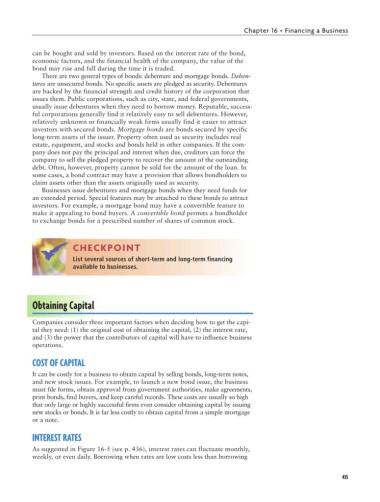Page 448 - Business Principles and Management
P. 448
Chapter 16 • Financing a Business
can be bought and sold by investors. Based on the interest rate of the bond,
economic factors, and the financial health of the company, the value of the
bond may rise and fall during the time it is traded.
There are two general types of bonds: debenture and mortgage bonds. Deben-
tures are unsecured bonds. No specific assets are pledged as security. Debentures
are backed by the financial strength and credit history of the corporation that
issues them. Public corporations, such as city, state, and federal governments,
usually issue debentures when they need to borrow money. Reputable, success-
ful corporations generally find it relatively easy to sell debentures. However,
relatively unknown or financially weak firms usually find it easier to attract
investors with secured bonds. Mortgage bonds are bonds secured by specific
long-term assets of the issuer. Property often used as security includes real
estate, equipment, and stocks and bonds held in other companies. If the com-
pany does not pay the principal and interest when due, creditors can force the
company to sell the pledged property to recover the amount of the outstanding
debt. Often, however, property cannot be sold for the amount of the loan. In
some cases, a bond contract may have a provision that allows bondholders to
claim assets other than the assets originally used as security.
Businesses issue debentures and mortgage bonds when they need funds for
an extended period. Special features may be attached to these bonds to attract
investors. For example, a mortgage bond may have a convertible feature to
make it appealing to bond buyers. A convertible bond permits a bondholder
to exchange bonds for a prescribed number of shares of common stock.
CHECKPOINT
List several sources of short-term and long-term financing
available to businesses.
Obtaining Capital
Companies consider three important factors when deciding how to get the capi-
tal they need: (1) the original cost of obtaining the capital, (2) the interest rate,
and (3) the power that the contributors of capital will have to influence business
operations.
COST OF CAPITAL
It can be costly for a business to obtain capital by selling bonds, long-term notes,
and new stock issues. For example, to launch a new bond issue, the business
must file forms, obtain approval from government authorities, make agreements,
print bonds, find buyers, and keep careful records. These costs are usually so high
that only large or highly successful firms even consider obtaining capital by issuing
new stocks or bonds. It is far less costly to obtain capital from a simple mortgage
or a note.
INTEREST RATES
As suggested in Figure 16-5 (see p. 436), interest rates can fluctuate monthly,
weekly, or even daily. Borrowing when rates are low costs less than borrowing
435

